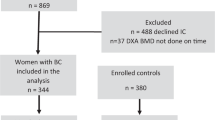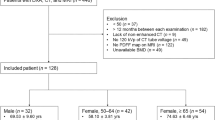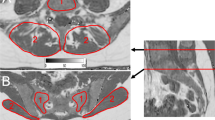Abstract
BACKGROUND/OBJECTIVES:
Recent research has shown an inverse relationship between bone marrow adipose tissue (BMAT) and bone mineral density (BMD). There is a lack of evidence at the macro-imaging level to establish whether increased BMAT is a cause or effect of bone loss. This cross-sectional study compared the BMAT and BMD relationship between a younger adult group at or approaching peak bone mass (PBM; age 18.0–39.9 years) and an older group with potential bone loss (PoBL; age 40.0–88.0 years).
SUBJECTS/METHODS:
Pelvic BMAT was evaluated in 560 healthy men and women with T1-weighted whole-body magnetic resonance imaging. BMD was measured using whole-body dual-energy X-ray absorptiometry.
RESULTS:
An inverse correlation was observed between pelvic BMAT and pelvic, total and spine BMD in the younger PBM group (r=−0.419 to −0.461, P<0.001) and in the older PoBL group (r=−0.405 to −0.500, P<0.001). After adjusting for age, sex, ethnicity, menopausal status, total body fat, skeletal muscle, subcutaneous and visceral adipose tissue, neither subject group (younger PBM vs older PoBL) nor its interaction with pelvic BMAT significantly contributed to the regression models with BMD as dependent variable and pelvic BMAT as independent variable (P=0.434–0.928).
CONCLUSIONS:
Our findings indicate that an inverse relationship between pelvic BMAT and BMD is present both in younger subjects who have not yet experienced bone loss and also in older subjects. These results provide support at the macro-imaging level for the hypothesis that low BMD may be a result of preferential differentiation of mesenchymal stem cells from osteoblasts to adipocytes.
This is a preview of subscription content, access via your institution
Access options
Subscribe to this journal
Receive 12 print issues and online access
$259.00 per year
only $21.58 per issue
Buy this article
- Purchase on Springer Link
- Instant access to full article PDF
Prices may be subject to local taxes which are calculated during checkout

Similar content being viewed by others
References
Wehrli FW, Hopkins JA, Hwang SN, Song HK, Snyder PJ, Haddad JG . Cross-sectional study of osteopenia with quantitative MR imaging and bone densitometry. Radiology 2000; 217: 527–538.
Shih TT, Chang CJ, Hsu CY, Wei SY, Su KC, Chung HW . Correlation of bone marrow lipid water content with bone mineral density on the lumbar spine. Spine 2004; 29: 2844–2850.
Griffith JF, Yeung DK, Antonio GE, Lee FK, Hong AW, Wong SY et al. Vertebral bone mineral density, marrow perfusion, and fat content in healthy men and men with osteoporosis: dynamic contrast-enhanced MR imaging and MR spectroscopy. Radiology 2005; 236: 945–951.
Shen W, Chen J, Punyanitya M, Shapses S, Heshka S, Heymsfield SB . MRI-measured bone marrow adipose tissue is inversely related to DXA-measured bone mineral in Caucasian women. Osteoporos Int 2007; 18: 641–647.
Di Iorgi N, Rosol M, Mittelman SD, Gilsanz V . Reciprocal relation between marrow adiposity and the amount of bone in the axial and appendicular skeleton of young adults. J Clin Endocrinol Metab 2008; 93: 2281–2286.
Quarto R, Thomas D, Liang CT . Bone progenitor cell deficits and the age-associated decline in bone repair capacity. Calcif Tissue Int 1995; 56: 123–129.
Mullender MG, van der Meer DD, Huiskes R, Lips P . Osteocyte density changes in aging and osteoporosis. Bone 1996; 18: 109–113.
Rickard DJ, Kassem M, Hefferan TE, Sarkar G, Spelsberg TC, Riggs BL . Isolation and characterization of osteoblast precursor cells from human bone marrow. J Bone Miner Res 1996; 11: 312–324.
Duque G . Bone and fat connection in aging bone. Curr Opin Rheumatol 2008; 20: 429–434.
Rosen CJ, Bouxsein ML . Mechanisms of disease: is osteoporosis the obesity of bone? Nat Clin Pract Rheumatol 2006; 2: 35–43.
Reid IR . Relationships between fat and bone. Osteoporos Int 2008; 19: 595–606.
Kyle UG, Piccoli A, Pichard C . Body composition measurements: interpretation finally made easy for clinical use. Curr Opin Clin Nutr Metab Care 2003; 6: 387–393.
Schellinger D, Lin CS, Lim J, Hatipoglu HG, Pezzullo JC, Singer AJ . Bone marrow fat and bone mineral density on proton MR spectroscopy and dual-energy X-ray absorptiometry: their ratio as a new indicator of bone weakening. AJR Am J Roentgenol 2004; 183: 1761–1765.
Kim H, Taksali SE, Dufour S, Befroy D, Goodman TR, Petersen KF et al. Comparative MR study of hepatic fat quantification using single-voxel proton spectroscopy, two-point dixon and three-point IDEAL. Magn Reson Med 2008; 59: 521–527.
Vande Berg BC, Malghem J, Lecouvet FE, Maldague B . Magnetic resonance imaging of normal bone marrow. Eur Radiol 1998; 8: 1327–1334.
Bosy-Westphal A, Later W, Schautz B, Lagerpusch M, Goele K, Heller M et al. Impact of intra- and extra-osseous soft tissue composition on changes in bone mineral density with weight loss and regain. Obesity (Silver Spring) 2011; 19: 1503–1510.
Abate N, Burns D, Peshock RM, Garg A, Grundy SM . Estimation of adipose tissue mass by magnetic resonance imaging: validation against dissection in human cadavers. J Lipid Res 1994; 35: 1490–1496.
Mitsiopoulos N, Baumgartner RN, Heymsfield SB, Lyons W, Gallagher D, Ross R . Cadaver validation of skeletal muscle measurement by magnetic resonance imaging and computerized tomography. J Appl Physiol 1998; 85: 115–122.
Brambilla P, Bedogni G, Moreno LA, Goran MI, Gutin B, Fox KR et al. Crossvalidation of anthropometry against magnetic resonance imaging for the assessment of visceral and subcutaneous adipose tissue in children. Int J Obes (Lond) 2006; 30: 23–30.
Ross R, Leger L, Morris D, Jd Guise, Guardo R . Quantification of adipose tissue by MRI: relationship with anthropometric variables. J Appl Physiol 1992; 72: 787–795.
Owens S, Litaker M, Allison J, Riggs S, Ferguson M, Gutin B . Prediction of visceral adipose tissue from simple anthropometric measurements in youths with obesity. Obes Res 1999; 7: 16–22.
Grunfeld C, Rimland D, Gibert CL, Powderly WG, Sidney S, Shlipak MG et al. Association of upper trunk and visceral adipose tissue volume with insulin resistance in control and HIV-infected subjects in the FRAM study. J Acquir Immune Defic Syndr 2007; 46: 283–290.
Xiang QS . Two-point water-fat imaging with partially-opposed-phase (POP) acquisition: an asymmetric Dixon method. Magn Reson Med 2006; 56: 572–584.
Meisamy S, Hines CD, Hamilton G, Sirlin CB, McKenzie CA, Yu H et al. Quantification of hepatic steatosis with T1-independent, T2-corrected MR imaging with spectral modeling of fat: blinded comparison with MR spectroscopy. Radiology 2011; 258: 767–775.
Kalkwarf HJ, Zemel BS, Gilsanz V, Lappe JM, Horlick M, Oberfield S et al. The bone mineral density in childhood study: bone mineral content and density according to age, sex, and race. J Clin Endocrinol Metab 2007; 92: 2087–2099.
Branca F, Valtuena S . Calcium, physical activity and bone health--building bones for a stronger future. Public Health Nutr 2001; 4: 117–123.
Khosla S, Riggs BL . Pathophysiology of age-related bone loss and osteoporosis. Endocrinol Metab Clin North Am 2005; 34: 1015–1030. xi.
Cromer B, Harel Z . Adolescents: at increased risk for osteoporosis? Clin Pediatr (Phila) 2000; 39: 565–574.
Russell-Aulet M, Wang J, Thornton J . Pierson RNJ. Comparison of dual-photon absorptiometry systems for total-body bone and soft tissue measurements: dual-energy X-rays versus gadolinium 153. J Bone Miner Res 1991; 6: 411–415.
Gallagher D, Belmonte D, Deurenberg P, Wang Z, Krasnow N, Pi-Sunyer FX et al. Organ-tissue mass measurement allows modeling of REE and metabolically active tissue mass. Am J Physiol 1998; 275 (2 Pt 1): E249–E258.
Heymsfield SB, Gallagher D, Kotler DP, Wang Z, Allison DB, Heshka S . Body-size dependence of resting energy expenditure can be attributed to nonenergetic homogeneity of fat-free mass. Am J Physiol Endocrinol Metab 2002; 282: E132–E138.
Bianco P, Gehron Robey P . Marrow stromal stem cells. J Clin Invest 2000; 105: 1663–1668.
Pittenger MF, Mackay AM, Beck SC, Jaiswal RK, Douglas R, Mosca JD et al. Multilineage potential of adult human mesenchymal stem cells. Science 1999; 284: 143–147.
Lazarenko OP, Rzonca SO, Hogue WR, Swain FL, Suva LJ, Lecka-Czernik B. . Rosiglitazone induces decreases in bone mass and strength that are reminiscent of aged bone. Endocrinology 2007; 148: 2669–2680.
Takada I, Suzawa M, Matsumoto K, Kato S . Suppression of PPAR transactivation switches cell fate of bone marrow stem cells from adipocytes into osteoblasts. Ann N Y Acad Sci 2007; 1116: 182–195.
Botolin S, McCabe LR . Inhibition of PPARgamma prevents type I diabetic bone marrow adiposity but not bone loss. J Cell Physiol 2006; 209: 967–976.
Takagi K, Kudo A . Bone marrow stromal cell lines having high potential for osteoclast-supporting activity express PPARgamma1 and show high potential for differentiation into adipocytes. J Bone Miner Metab 2008; 26: 13–23.
Wan Y, Chong LW, Evans RM . PPAR-gamma regulates osteoclastogenesis in mice. Nat Med 2007; 13: 1496–1503.
Sen B, Xie Z, Case N, Styner M, Rubin CT, Rubin J . Mechanical signal influence on mesenchymal stem cell fate is enhanced by incorporation of refractory periods into the loading regimen. J Biomech 2011; 44: 593–599.
Gimble JM, Zvonic S, Floyd ZE, Kassem M, Nuttall ME . Playing with bone and fat. J Cell Biochem 2006; 98: 251–266.
Matkovic V, Jelic T, Wardlaw GM, Ilich JZ, Goel PK, Wright JK et al. Timing of peak bone mass in Caucasian females and its implication for the prevention of osteoporosis. Inference from a cross-sectional model. J Clin Invest 1994; 93: 799–808.
Heaney RP, Abrams S, Dawson-Hughes B, Looker A, Marcus R, Matkovic V et al. Peak bone mass. Osteoporos Int 2000; 11: 985–1009.
Bolotin HH, Sievanen H, Grashuis JL . Patient-specific DXA bone mineral density inaccuracies: quantitative effects of nonuniform extraosseous fat distributions. J Bone Miner Res 2003; 18: 1020–1027.
Hangartner TN, Johnston CC . Influence of fat on bone measurements with dual-energy absorptiometry. Bone Miner 1990; 9: 71–81.
Di Iorgi N, Mo AO, Grimm K, Wren TA, Dorey F, Gilsanz V . Bone acquisition in healthy young females is reciprocally related to marrow adiposity. J Clin Endocrinol Metab 2010; 95: 2977–2982.
World Health Organization.. Assessment of fracture risk and its application to screening for postmenopausal osteoporosis: report of a WHO study group Report No.: 843. Technical Report Series, World Health Organization: Geneva, Switzerland, 1994.
Engelke K, Libanati C, Liu Y, Wang H, Austin M, Fuerst T et al. Quantitative computed tomography (QCT) of the forearm using general purpose spiral whole-body CT scanners: accuracy, precision and comparison with dual-energy X-ray absorptiometry (DXA). Bone 2009; 45: 110–118.
Duque G, Li W, Adams M, Xu S, Phipps R . Effects of risedronate on bone marrow adipocytes in postmenopausal women. Osteoporos Int 2011; 22: 1547–1553.
Acknowledgements
The project described was supported by Award Number R21DK082937 from the National Institute Of Diabetes and Digestive and Kidney Diseases, United States. The content is solely the responsibility of the authors and does not necessarily represent the official views of the National Institute Of Diabetes and Digestive and Kidney Diseases or the National Institutes of Health. The project was also supported by National Institutes of Health Grants R01 DK40414, R01 DK42618, and P30 DK26687, R29-AG14715, F32-AG05679, M01 RR00645, UL1 RR024156.
Author information
Authors and Affiliations
Corresponding author
Ethics declarations
Competing interests
The authors declare no conflict of interest.
Rights and permissions
About this article
Cite this article
Shen, W., Chen, J., Gantz, M. et al. MRI-measured pelvic bone marrow adipose tissue is inversely related to DXA-measured bone mineral in younger and older adults. Eur J Clin Nutr 66, 983–988 (2012). https://doi.org/10.1038/ejcn.2012.35
Received:
Revised:
Accepted:
Published:
Issue Date:
DOI: https://doi.org/10.1038/ejcn.2012.35
Keywords
This article is cited by
-
CircZNF367 suppresses osteogenic differentiation of human bone marrow mesenchymal stromal/stem cells via reducing HuR-mediated mRNA stability of LRP5
Human Cell (2022)
-
Opportunistic Use of Lumbar Magnetic Resonance Imaging for Osteoporosis Screening
Osteoporosis International (2022)
-
Adipogenic progenitors in different organs: Pathophysiological implications
Reviews in Endocrine and Metabolic Disorders (2022)
-
Bone marrow magnetic resonance imaging: physiologic and pathologic findings that radiologist should know
La radiologia medica (2021)
-
Quantifying bone marrow fat using standard T1-weighted magnetic resonance images in children with typical development and in children with cerebral palsy
Scientific Reports (2020)



